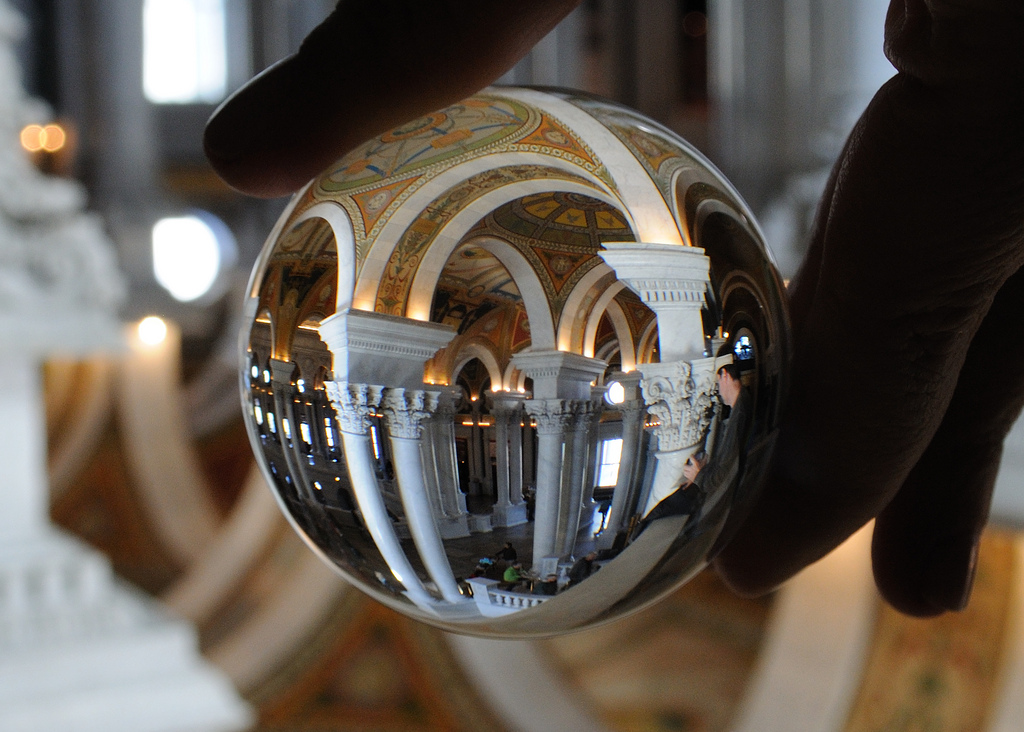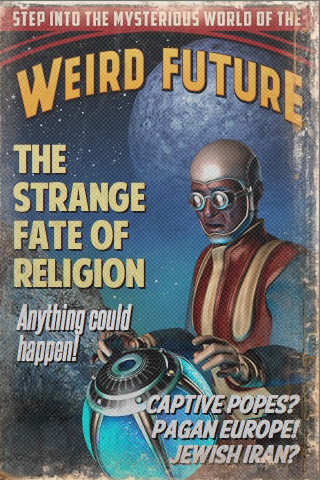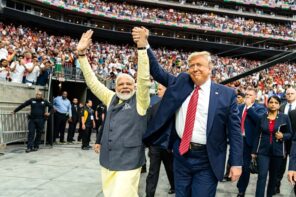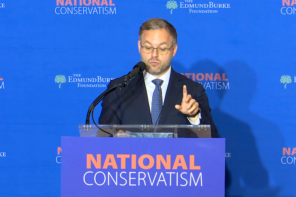This week’s news from Pew on the decline of institutional Christianity, with its trove of data on the “unaffiliated” and the decline of the mainstream, has stolen the stage from last month’s release of Pew’s report on the Future of World Religions—a study that concluded that while atheists, agnostics and the unchurched are on the rise in the U.S. their numbers are projected to decline globally. But while Pew’s prediction that Islam will overtake Christianity made headlines, the authors of the study were quick to remind us that their findings are not the direct results of polling but projections.
It would seem hard enough to project something as simple as population growth, but what of the mercurial nature of religious faith itself? It might well be impossible to predict the “turn of the soul” for one individual, let alone that of an entire community.
As a type of thought experiment let’s imagine a hypothetical “Court Demographer” working under the Tudor King Henry VIII in 1515. What sort of conclusions might he draw from an overview of the European situation at the time?
He might have concluded that despite constant Ottoman pressure on her eastern border the Roman Catholic faith was secure in its dominance. Indeed with the arrival of Spanish colonialism throughout the Americas it seemed as if Catholicism as the Christian hegemon would spread into recently discovered worlds. A conventionally pious and conservative Catholic who would indeed be named a “Defender of the Faith” in 1521 by Pope Leo X occupied the English throne.
The Court Demographer might have predicted that Catholicism would spread by force into the Americas and by missionary activity into Asia.
He might have seen the possibility of the humanist intellectual vanguard with figures like Erasmus and Thomas More reforming the Church from the inside. In their calls for suppression of corruption and simony the Demographer may have seen a tidied up or simplified Catholicism reigning in Rome, especially under the influence of reform-minded clergy like the Spanish cardinal Gasparo Contarini and other representatives of the spirituali movement. And based on the near successes of the Council of Florence in 1454 he may have hoped for the reconciliation of the various Orthodox churches to the See of Rome.
But what would the Court Demographer been unable to imagine in 1515? That an Augustinian monk named Martin Luther would nail 95 theses to the church door in Wittenberg and launch a wave of reform.
Certainly Luther’s grievances were well-known, especially in northern Europe. But the Court Demographer might have thought that Erasmus and his fellow Humanists could handle it. And Luther’s theology wasn’t original (as he himself would, in fact had to, acknowledge). Any Court Demographer worth his hypothetical salt would have been aware of the presence of pesky Lollards, often prominent within London’s lucrative wool trade, who even more than a century after their emergence preached a gospel of salvation through faith and scriptural inerrancy.
And the Court Demographer would be aware of the dangers of schism and heresy, whether that be of the fourteenth-century Papal Babylonian Captivity or the radicalism of non-Catholic groups like the Cathars and Bogomils (extinct by 1515) or the Waldensians (who were not). And while preachers every bit as fiery as Luther had preached against the Church from the middle ages to the Court Demographer’s current day, what had figures like Joachim of Fiora or Savonarola come to?
So it would seem unlikely that this prognosticator could see Luther and the five centuries which resulted.
We have to ask: what new Luthers might be out there? What multiple “turns of the soul” could occur in the collective body-politic to spur revolutions in religion?
Back to the Future
In the manner of our dear imaginary Court Demographer, let’s imagine what it might be like to look back, a hundred years from now, on religious change in the 21st century.
A 22nd century historian might find herself describing how the United States, long known as an unusually pious nation (Chesterton’s country with the “soul of a church”) saw a large percentage of its citizens become increasingly secular. Indeed this is born out by the Pew study itself. Close to a fifth of Americans are religiously unaffiliated—albeit an incredibly diverse group that contains agnostics, atheists, people who identify as spiritual if not religious, and the generally non-denominational among others. Already the unaffiliated occupy the second largest “religious” group in the United States.
Despite significant differences among members (who are after all defined by not belonging to a group) will they coalesce into a group that needs to be politically courted?
Politicians in both the Republican and Democratic parties shy away (or openly denounce) atheist Americans, will atheist, agnostic and other secular voters demand respect in the same way other marginalized religious groups have in the past? Is it possible that our future historian might need to comment on the election of America’s first atheist President? With no admitted atheist members of Congress in 2015 it seems impossible to conceive of an atheist executive in the next hundred years—but it could happen.
At the same time the diversity of secular Americans shouldn’t be deemphasized. As an incredibly multifaceted group its members run the gamut from a socialistic left to a libertarian right. Indeed those who have coalesced around the more militant “New” Atheists often embrace a range of right-wing enthusiasms from Randian economics to anti-feminism even while the traditionally irreligious are normally seen as more liberal.
And might new “faith-like” communities emerge from the debris of doubt and skepticism? Already there have been formal incorporations of committed atheists and agnostics into “churches” with “ministers” preaching a gospel of scientism, skepticism, and present-world centered ethics.
For anyone who has read Sagan’s inspiring Pale Blue Dot it is hard not to admit that if feelings of awe at our place in the universe aren’t “religious” they are at least numinous and transcendent. As science continues the Copernican revolution of unseating humanity from its primacy, secular or atheistic “churches” may play a role in cultivating a sense of awe in the face of human insignificance.
What other religious changes might the United States see?
This week’s Pew results seem to suggest that despite a secular upswing evangelicals and Pentecostals will hold strong or increase their numbers. Our historian looking back on the twenty-first century may indeed lament the collapse of mainstream Protestantism in the United States, which at one time undergirded so much of American identity. She may lament that the country now seems split between an irreligious half and an evangelical one.
What about the Roman Catholic Church in the United States? In many ways the future of the Catholic Church in the U.S. will be dependent on its future elsewhere in the world. Will there be a large, welcoming, liberal Church following the example of Pope Francis and possibly even more reformist coming popes? Will there be a Church that attends to the beliefs of most American Catholics or will the church become ever more conservative?
What moments might we miss that seem obvious to our future historian? Will she write about some unpredicted future Great Awakening of evangelical fervor in American society? Need this Great Awakening be reactionary, or could it be progressive?
Or maybe as national political prestige and a sense of American exceptionality withers people will replace our civil religion for Mormonism, with Americans embracing the church’s American-centered cosmology and stable sense of family values. It’s the largest religious tradition actually birthed in America and remains one of our fastest growing religions—could it be possible that the twenty first century sees Mormonism becoming America’s dominant religion?
And what about Europe? The Pew study indicates that traditional Christianity is dying out in Europe even as Islam increases. Will Europe react with its own evangelical revival? Might the burned-over country of the nineteenth-century Adirondacks and Alleghenies be replaced with that of the twenty-first century Black Forest?
Or will Europeans embrace that really old time religion of paganism, trading in Christ for Thor? Perhaps our future historian will write her dissertation on how the twenty-first century saw mass revivals of the worship of Apollo in Greece, Diana in Italy, and Odin in Scandinavia? And what portents may neo-Paganism herald, what rough beast slouches toward London, Paris, and Rome to be born? Will it be a Neo-Paganism embracing the democratic egalitarianism of classical polytheism, or will it be a racist, xenophobic, and chauvinist appropriation of traditional symbols and rites?
Will it be a neo-Paganism of the ‘60s Left or of Alain de Benoist and his New Right?
Of course the biggest question about religion in Europe is the future of the Roman Catholic Church, whose increasingly diverse membership— in the “Global South” of South America, Africa and Asia— promises to radically alter its face.
After the College of Cardinals elected the first non-European Pope in more than a century (albeit one of Italian descent) it seems unthinkable that the next Pope won’t come from Asia, Africa, or South America. A Pope from the United States seems unlikely, as the United States Conference of Catholic Bishops has myopically acted as a virtual rung of the Republican Party. Whatever the American bishops have in common with the wider church, GOP policies on economics or militarism are foreign to church teaching whether the pope is Francis or Benedict XVI. As a result, despite theological conservatism within the College of Cardinals, American bishops are viewed with suspicion within the Curia.
Expect the next Pope to be from Manila or Yaoundé and not from Boston or Chicago.
Whether this will herald a more progressive church or a reactionary one is a matter of debate. Right now Pope Francis is attempting to extend his influence beyond the end of his papacy as much as possible by selecting the cardinals who will elect the next pope.
As it stands now there are a few things that may happen upon Pope Francis’ passing: the Church will either get more liberal or it will not, and the Church will either get more ecumenical or it will not. Signs show that the incredibly popular Pope Francis has reinvigorated lapsed Catholics around the world, and especially in the United States (where he will make his first visit this fall).
Lapsed Catholics are themselves a sizable percentage of America’s religious makeup, and by refocusing attention away from divisive culture war issues and towards questions of social justice (which are actually addressed directly by the gospels) Pope Francis has earned a reprieve for a Church still reeling from the horrors of sex abuse allegations and other scandals.
Can we hope for a Vatican III to suggest more radical changes than last year’s Synod on the Family? Or will cardinals, threatened by the spectacle of this social media-savvy progressive-leaning Pope, double down and elect an archconservative?And there is the possibility that even if more liberal popes are to follow that the conservative wings within Catholicism will threaten schism.
Already Catholic bishops enraptured by an Opus Dei worldview have suggested a break with Rome. It’s possible that the twenty-first century could see something that seems more like a fourteenth-century spectacle—a post-modern Babylonian Captivity of the Papacy with dueling popes and anti-popes and a new Avignon in Bogota or Sao Paulo.
In contrast to schism there is also the possibility of ecumenical reconciliation. The past millennium has seen numerous approaches for a reunification between the Latin Catholic West and the Greek Orthodox East. With the coming millennial anniversary of their split in 2054 will the spiritual descendants of Rome and Constantinople achieve a waited-for reconciliation?
Is it possible that our future historian will note a diminished interest in obscure theological differences between the Catholic and Orthodox? In the case of reconciliation how will the Orthodox find papal authority palatable? And what will the next half-century see in Russia, where Moscow has attempted to culturally usurp Constantinople as the metonymous symbol of Orthodoxy? And what of other ecumenical treaties? Will the Church of England reenter the Catholic fold? Various Lutheran denominations?
And what of the rest of the world (acknowledging that what will be presented in a woefully inadequate account of the remaining globe)? Burgeoning Russian nationalism has already seen the beginnings of a unification of church and state with Vladimir Putin commandeering theological language as he continues to consolidate authority in Moscow. Will the twenty-first century see the rise of a Russia emboldened by a mixture of Slavic nationalism and Orthodox mysticism? Does this signal the origins of a modern theocratic state with draconian social laws (such as Russia’s current homophobic statutes) at home and a belligerent foreign policy outside of its borders?
The Pew Study indicates that the number of Jews in the world will remain constant even as the religion’s adherents grow older. What will Israel look like in the twenty-first century? With Benjamin Netanyahu’s insistence on holding to a hardline definition of Jewish identity in relation to the state will we see an increasingly religious Israeli state moving away from the secular origins of Zionism? Is the worst-case scenario the emergence of a religious state that mimics what one imagines a Jewish version of Iran would look like? Or will our future historian note the emergence of a now unknown statesman in the tradition of Yitzhak Rabin who is able to move Israel back to the center?
And with increased anti-Semitism in Europe, which has often gone painfully unnoticed by the popular press, will Israel (or the United States) see an influx of Jewish immigrants, altering the situation in Israel in completely unseen ways?
Africa will not only see an increase in adherents to Christianity and Islam, it will also (as the Pew study indicates) see an increase in “indigenous” beliefs. The growing power of radical Islam in the form of groups like Boko Haram in Nigeria much as with the emergence of ISIS in Iraq and Syria could possibly signal the beginnings of a terrifying new chapter in religious oppression. Will our future historian write about bloody religious crusades between Muslims and Christians in the new Global South? Or will small but growing secular movements in Africa and Asia prevent this?
What will our historian say about the growth of “indigenous” religion? From Max Muller to Mircea Eliade western scholars have often patronizingly collapsed the distinctions between African, Indian, Asian, and Pacific “indigenous beliefs.” How will westerners react when finally forced to confront these religious systems on their own terms? Stephen Prothero has pointed out that the traditional African religion of Yoruba is one of the world’s largest faiths and in his brilliant new book One Nation under Gods Peter Manseau has shown how the crucial role African religion played in the development of American religious syncretism. How will increased interaction with these religions enrich our global sense of faith?
And what of Asia? Will our future historian chart the ways that Hindu nationalism in India embraced an increasingly fundamentalist version of the faith? Will the Dalai Lama choose not to reincarnate? In China itself there is the possibility (as mentioned earlier) of China becoming the largest Christian nation on Earth.
Finally, what are the totally unforeseen movements, religions, events, and scriptures that will emerge in the next hundred years? What syncretism will our historian note? What religions totally impossible for us to imagine will she write about? What will quickly emerge from some forgotten place to overtake the world?
These possibilities are only possibilities until the wave function collapses—until then our tea leaves and tarot cards are only that, no matter how technologically sophisticated. The demographer’s job is by necessity a humble one. Just as surely as we can reflect on things that our imaginary Tudor could have never anticipated, our future historian understands things that we’d never have been able to predict.
In prognosticating the future of religion it’s helpful to keep in mind that great philosopher-who-strived-towards-Christianity Soren Kierkegaard who wrote, “Life can only be understood backwards; but it must be lived forwards.”






